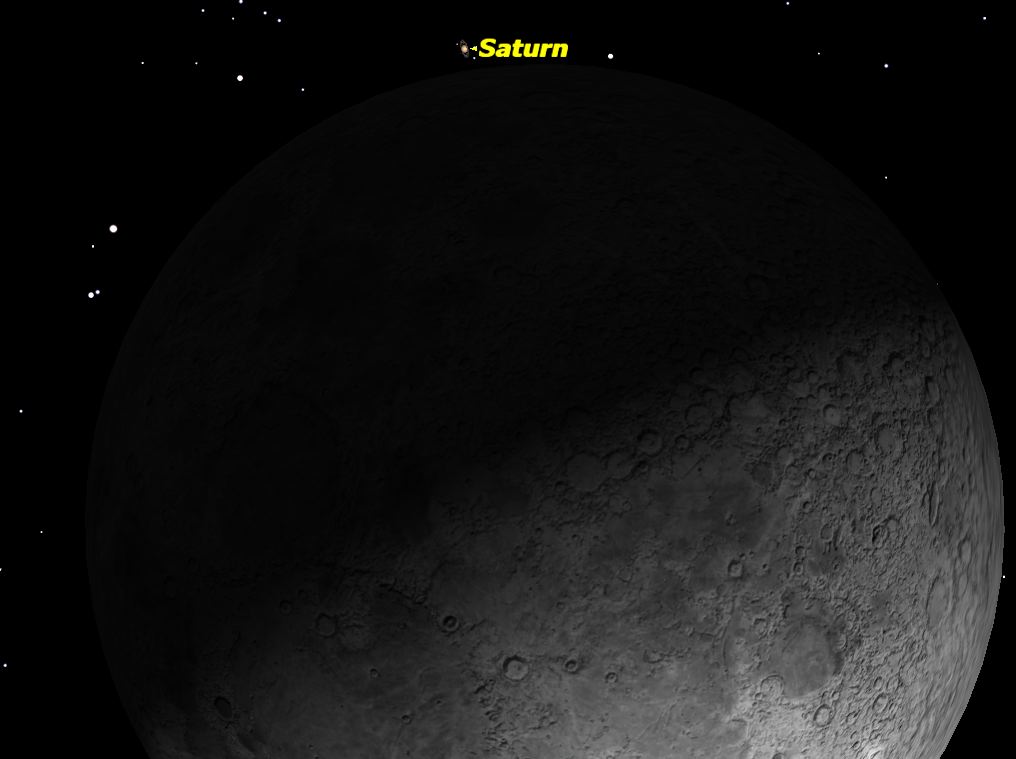
On Wednesday night of this week (Feb. 19), the moon had a rendezvous with the bright star Spica and the planet named for the god of war: Mars. And early on Saturday morning (Feb. 22), if skies are clear, you’ll have an opportunity to catch sight of the last quarter moon pairing off with another planet, the ringed wonder of the solar system, Saturn.
Start looking low toward the east-southeast horizon shortly after 1 a.m. local time on Friday night/Saturday morning. Soon after the moon emerges from beyond the horizon, you’ll notice a bright, non-twinkling yellow-white "star" shining sedately well above and to its right.
That will be Saturn. [Best Night Sky Events of February 2014: Stargazing Sky Maps]
If you have any obstructions such as buildings or trees in that direction, you might have to wait awhile as the celestial pair slowly climbs higher in the sky.
The duo will be at its highest, appearing roughly one-third of the way from the horizon to the point directly overhead (the zenith), at around 5:30 a.m. local time. By that time, Saturn will appear about 7 degrees to the right of the moon. (Your clenched fist held at arm’s length measures about 10 degrees).
If you look a similar distance to Saturn’s right, you may note the third-magnitude star with the tongue-twisting name of Zubenelgenubi (pronounced "zoo-BEN-el-je-NEW-bee") in the constellation of Libra, the Scales. If you have binoculars, train them on Zubenelgenubi; you’ll see that it’s a wide double.
You’ll need more than binoculars, however, to bring out the famous rings of Saturn. A telescope magnifying at least 30-power will reveal the famous rings, now tilted more than 22.5 degrees to our line of sight. The rings won’t be inclined so much again until mid-October, when Saturn will be less favorably placed. Saturn is currently 898 million miles (1.44 billion kilometers) from Earth. The moon, on the other hand, is nearly 3,900 times closer.
Get the Space.com Newsletter
Breaking space news, the latest updates on rocket launches, skywatching events and more!
Note also the 1st-magnitude reddish star Antares well down to Saturn’s lower left. Between them lies the head of Scorpius, the Scorpion, resembling a "fence" of 2nd- and 3rd-magnitude stars. Saturn is still nearly three months from opposition and as such will continue to slowly grow in prominence in the days and weeks to come.
Editor's note: If you have an amazing picture of the moon, Saturn or any other night sky view that you'd like to share for a possible story or image gallery, send photos, comments and your name and location to managing editor Tariq Malik at spacephotos@space.com.
Joe Rao serves as an instructor and guest lecturer at New York's Hayden Planetarium. He writes about astronomy for Natural History magazine, the Farmer's Almanac and other publications, and he is also an on-camera meteorologist for News 12 Westchester, N.Y. Follow us @Spacedotcom, Facebook or Google+. Originally published on Space.com.
Join our Space Forums to keep talking space on the latest missions, night sky and more! And if you have a news tip, correction or comment, let us know at: community@space.com.

Joe Rao is Space.com's skywatching columnist, as well as a veteran meteorologist and eclipse chaser who also serves as an instructor and guest lecturer at New York's Hayden Planetarium. He writes about astronomy for Natural History magazine, Sky & Telescope and other publications. Joe is an 8-time Emmy-nominated meteorologist who served the Putnam Valley region of New York for over 21 years. You can find him on Twitter and YouTube tracking lunar and solar eclipses, meteor showers and more. To find out Joe's latest project, visit him on Twitter.









